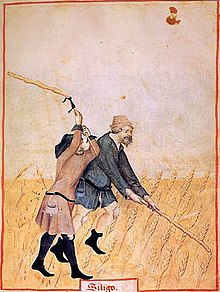Pocket: Difference between revisions
m Switch images, add section break, more to come |
→External links: Added links relating to 18th century women's pockets |
||
| Line 43: | Line 43: | ||
{{Commons category|pockets}} |
{{Commons category|pockets}} |
||
* [http://www.bbc.co.uk/dna/h2g2/A798159 BBC - h2g2 - A Very Brief History of the Pocket] |
* [http://www.bbc.co.uk/dna/h2g2/A798159 BBC - h2g2 - A Very Brief History of the Pocket] |
||
*[http://larsdatter.com/18c/pockets.html 18th Century Women's Pockets] |
|||
*[http://www.vam.ac.uk/collections/fashion/features/pockets/collections/index.html Pockets at the V&A] |
|||
*[http://www.vads.ahds.ac.uk/collections/POCKETS.html Pockets of History] |
|||
{{Clothing}} |
{{Clothing}} |
||
Revision as of 04:39, 1 September 2010
It has been suggested that jacket pocket be merged into this article. (Discuss) Proposed since July 2010. |
It has been suggested that Besom pocket be merged into this article. (Discuss) Proposed since August 2010. |

A pocket is a bag- or envelope-like receptacle either fastened to or inserted in an article of clothing to hold small items. Pockets may also be attached to luggage, backpacks, and similar items. In older usage, a pocket was a separate small bag or pouch.[1]
Origins

In European clothing pockets began by being hung like purses from a belt, which could be concealed beneath a coat or jerkin and reached through a slit in the outer garment.
The word appears in Middle English as poket, and is taken from a Norman diminutive of Old French poke, pouque, modern poche, cf. pouch. The form "poke" is now only used dialectically, or in such proverbial sayings as "a pig in a poke".
Historically, the term "pocket" referred to a pouch worn around the waist by women in the 17th to 19th centuries, mentioned in the rhyme Lucy Locket.[2] Also called a hanging pocket.
"Pocket" is also a term for a sack in which hops were stored, generally with a capacity of 168–224 lb (76–102 kg).[citation needed]
Types
A watch pocket is a small pocket designed to hold an old style pocket watch, sometimes found in men's trousers and waistcoats and in traditional blue jeans.
-
Patch pocket.
-
Patch pocket with topstitching.
-
Flap pocket.
-
Buttoned-flap patch pocket with box pleat.
-
"Smile" slit pocket with piping and arrowhead reinforcements, typical of western wear.
-
Bound or double-welt pocket.
-
Stand or single-welt pocket.
-
18th century-style hanging pocket.
-
Parts of a tailored pocket.
-
Hip or "frontier" pocket with inner watch pocket.
Notesfrontier
- ^ Picken (1957), p. 258
- ^ "Historic New England: Defining the Past. Shaping the Future". Spnea.org. Retrieved 2009-08-20.
References
- Picken, Mary Brooks (1957). The Fashion Dictionary. Funk and Wagnalls.
{{cite book}}: Unknown parameter|link=ignored (help) - "Pockets". Fashion & Jewellery Features. Victoria and Albert Museum. Retrieved 2009-11-17.










